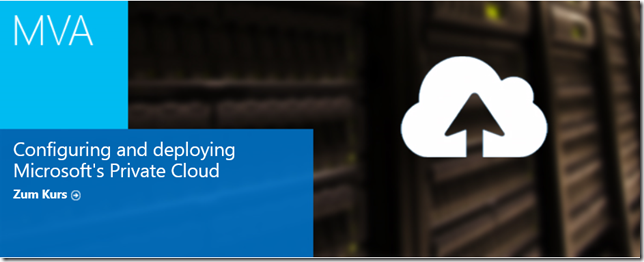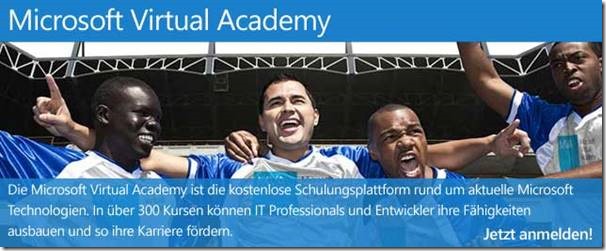“Einrichten und Ausrollen einer Private Cloud mit Microsoft Technologien” absolvieren und gewinnen!!
Zugegebenermaßen ist das nicht mehr der neueste Kurs auf der Microsoft Virtual Academy. Nichts desto trotz bietet dieser Kurs immer noch eine Vielzahl an interessanten Informationen. Und gewinnbringend ist der Kurs allemal, siehe Gewinnspiel am Ende dieses Beitrags!!
In diesem kostenlosen Online-Training der Microsoft Virtual Academy wird demonstriert, wie Sie eine Private Cloud planen und aufbauen. Sie lernen alles, was Sie über die Kernanwendungen für Windows Server und System Center wissen müssen, um Ihre virtualisierten und physischen Ressourcen in der Cloud verwalten zu können. Die Referenten der Microsoft Virtual Academy führen Sie Schritt-für-Schritt durch Konfiguration und Management Ihrer Cloud, zeigen Ihnen technische Details und erläutern Ihnen Beispiele dazu.
Da das Training in englischer Sprache abläuft, anbei auch die Inhaltsbeschreibung in englisch:
During the 8 modules of this specialization, you will be introduced to all the elements of building the Microsoft private cloud. You’ll learn how to optimize and deploy the private cloud starting at the infrastructure layer. You’ll also be introduced to advanced virtualization management features and the concept and implementation of the System Center’s private cloud application service model.
After completing all of the modules you will have an understanding of:
- How using Microsoft System Center 2012 can help you build, deploy and manage a private cloud infrastructure.
- How System Center 2012 incorporates tools to deploy, update, and manage applications within your private cloud.
- System Center 2012’s new abilities to deploy, update, and manage applications within your private cloud.
- How using new components of System Center 2012, specifically the Orchestrator and Service Manager components, enable you to deploy, update, and manage service offerings within your private cloud.
- How applications are deployed and managed in the Microsoft private cloud.
- How to use new capabilities in System Center 2012 to deploy your applications as services.
Die Inhalte der einzelnen Module:
- 01 | Configure and Deploy Infrastructure Components
This module explains how to build a private cloud, with specific focus on individual infrastructure components that enable this. It explains how System Center 2012 gives you a set of tools to configure and deploy infrastructure components including compute, storage, network, and cluster resources. It will show you how to use System Center to build a private cloud, discussing advanced topics such as bare-metal deployment of compute resources, optimizing storage components, and creating logical networks in the private cloud. - 02 | Configure and Deploy Private Cloud Infrastructure
This module explains how enterprise data centers are evolving toward highly virtualized infrastructures. It explains how System Center 2012 gives you a set of tools to configure and deploy Infrastructure resources and manage the environment; both the underlying physical infrastructure and the virtualized infrastructure. This module will show you how to use System Center to build a private cloud that aligns with the Microsoft cloud and data center management vision, to deliver common management experiences across private and public clouds. The module illustrates how to deliver IT as a service on your terms with flexible management across your hybrid cloud environments. - 03 | Configure and Deploy Service Delivery & Automation
This module will show you how to use System Center to design a private cloud that aligns with the Microsoft cloud and application management vision. This vision will deliver standardization of your service and request offerings, as well as standardizing your automation process. Further, we will illustrate Microsoft’s approach to self-service delivery. Specifically showing you examples of how to use the new portal functionality in System Center 2012, to empower your end users to request service offerings based on their role in the organization. Then we will detail how the approval and delivery of these offerings occurs. - 04 | Configuration & Deployment
This module explains the concept of application services and covers the types of services available to you, as well as the basic steps needed to configure and deploy that service. You’ll learn how to use new tools in System Center 2012 to manage the underlying resources of an application using the service template model, and how to delegate control and access to those templates. We’ll also how to work with developers to optimize applications for service-level monitoring across both private and public clouds. - 05 | Monitor and Operate Infrastructure Components
This module explains how to build a private cloud, with specific focus on individual infrastructure components that enable this. It explains how System Center 2012 gives you a set of tools to monitor and operate your infrastructure components, enabling you to keep your infrastructure components up and running. We further explain how to understand your infrastructure through performance monitoring, as well as how to optimize the health of your infrastructure. These practices will enable you to monitor applications deployed in your private cloud and on Windows Azure, further allowing you to increase overall data center availability. - 06 | Monitor and Operate Private Cloud Infrastructure
In this module you will learn the benefits of monitoring and operating virtualized infrastructure services in System Center 2012. As well, you will understand the benefits of using services in System Center 2012. Through this module, you will see how using System Center 2012 to provision your private cloud infrastructure and applications can deliver a flexible and cost-effective infrastructure. This module will teach you the basics of deploying and upgrading your virtual environment, the fundamentals of fabric management, and private cloud operating scenarios. By learning the fundamentals of building and delegating clouds, you will be able to better provision and optimize your application services and virtualization management practices. - 07 | Monitor and Operate Service Delivery & Automation
This module builds on the previous module, and further explains the advanced monitoring and operating functionality of two key System Center components, Orchestrator and Service Manager. This will show how IT Pros will gain end-to-end visibility into the automated processes that make their private clouds. Further, to ensure accurate and timely responses to end-user service requests, we will review System Center’s new service level agreement functionality. This provides the IT Pro with expedited methods to challenging operational issues such as release, incident and change management. Part of this module will be dedicated to new reporting functionality that allows the IT Pro to maintain a consistent window into the private cloud using System Center’s business intelligence and dashboard capability. - 08 | Application Services Management, Operation & Management
In this module you will learn new ways to operate and manage applications and workloads using the service template paradigm. New tools in System Center 2012 will allow for improved performance and monitoring of your applications. You’ll learn how to keep your applications running healthy and how to quickly re-allocate resources to ensure they continue to be healthy in the case of unforeseen problems or new requirements. You’ll see how these new tools can radically decrease the time required to resolve problems by giving IT administrators the ability to drill down to the performance characteristics of individual virtual and physical service resources, as well as at the code level. See how System Center 2012 will provide this new level of insight into the applications your organization depends upon to do business, and how you can use that insight not just to keep those applications running smoothly, but to make them perform at a new level.
Also ein ganzer Haufen an interessanten Inhalten, die man dann auch gleich in die Praxis umsetzen kann.
Viel Spaß beim Lernern!!
OK, jetzt aber zum Gewinnspiel: Habt Ihr Verwendung für einen 32GB Memory Stick? Ja? Dann mache ich Euch das folgende Angebot:
Alle die bis zum 14. September diesen Kurs fertiggestellt, in Ihrem MVA Profil sichtbar gemacht und uns rechtzeitig benachrichtigt haben bekommen von uns einen 32GB Memory Stick zugeschickt. Na? Ist das ein Angebot?
Gewinnspielanleitung im Detail:
1.) Kurs “Configuring and deploying Microsoft's Private Cloud” komplett absolvieren (=100% abgeschlossen).
2.) Komplettierte Kurse im MVA Profil sichtbar machen:
-
- Zu den Profileinstellungen navigieren: https://www.microsoftvirtualacademy.com/MyMVA/MyProfile.aspx
- Im Abschnitt “Persönliche Daten” den Punkt “meine Profildaten fuer alle Nutzer freigeben” aktivieren
- Im Abschnitt “Mein Status in der MVA” den Punkt “Tracks” aktivieren
3.) E-Mail an Gerhard.Goeschl@Microsoft.com mit dem Link auf das öffentliche MVA-Profil (z.B. https://www.microsoftvirtualacademy.com/Profile.aspx?alias=1053866 Danke Georg für den Hinweis!!
WICHTIG: Um teilzunehmen muss das E-Mail spätestens am 14. September 2014, 23:59 abgeschickt werden!!
Und hier noch das Kleingedruckte (muss leider sein):
Veranstalter ist die Microsoft Österreich GmbH. Teilnahmeberechtigt sind alle Personen mit Hauptwohnsitz in Österreich und einer österreichischen postalischen Zustelladresse. Von der Teilnahme ausgeschlossen sind Mitarbeiter von Microsoft und deren Angehörige sowie Amtsträger. Minderjährige sind teilnahmeberechtigt, wenn der gesetzliche Vertreter in die Teilnahme und in diese Teilnahmebedingungen vorher eingewilligt hat.
Teilnahmevoraussetzung ist die Komplettierung (=100% abgeschlossen) des Kurses “Configuring and deploying Microsoft's Private Cloud” die Veröffentlichung des Kursabschlusses im MVA Profil des Teilnehmers (https://www.microsoftvirtualacademy.com/MyMVA/MyProfile.aspx) sowie die Bekanntgabe per E-Mail an Gerhard.Goeschl@Microsoft.com bis spätestens 14. September 2014 23:59. Es gilt die Datums- und Uhrzeitangabe bei Eintreffen in der Inbox von Gerhard.Goeschl@Microsoft.com. Der Rechtsweg ist ausgeschlossen
Wenn mehr Einreichungen erfolgen als Preise vergeben werden können behalten wir uns vor die Vergabe der Gewinne anhand der Reihung der Meldung durchzuführen und gegebenenfalls den Wettbewerb frühzeitig zu beenden. Wir behalten uns dementsprechend vor, die Teilnahmebedingung gegebenenfalls zu ändern, und hier entsprechend zu veröffentlichen.
Die Gewinner werden per E-Mail verständigt und erklären sich mit der Veröffentlichung des Vornamens und des Anfangsbuchstabens des Nachnamens auf TechNet Austria einverstanden. Der Rechtsweg ist ausgeschlossen und die Ausbezahlung in bar nicht möglich. Mit Ihrer Teilnahme stimmen Sie diesen Teilnahmebedingungen vollständig und bedingungslos zu.
Durch das Absenden Ihrer Daten willigen Sie in die Speicherung Ihrer Daten durch die Microsoft Corporation in den USA und der Microsoft Österreich GmbH ein. Die erhobenen Daten dienen einzig der Auslosung und Benachrichtigung der Gewinner, sie werden nicht zu anderen Werbezwecken genutzt oder an Dritte weitergegeben. Diese Einwilligung können Sie jederzeit mit Wirkung für die Zukunft widerrufen. Ein Widerspruch ist an Microsoft Österreich GmbH, Am Europlatz 3, A-1120 Wien, oder an austria@microsoft.com zu richten.

